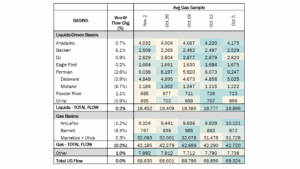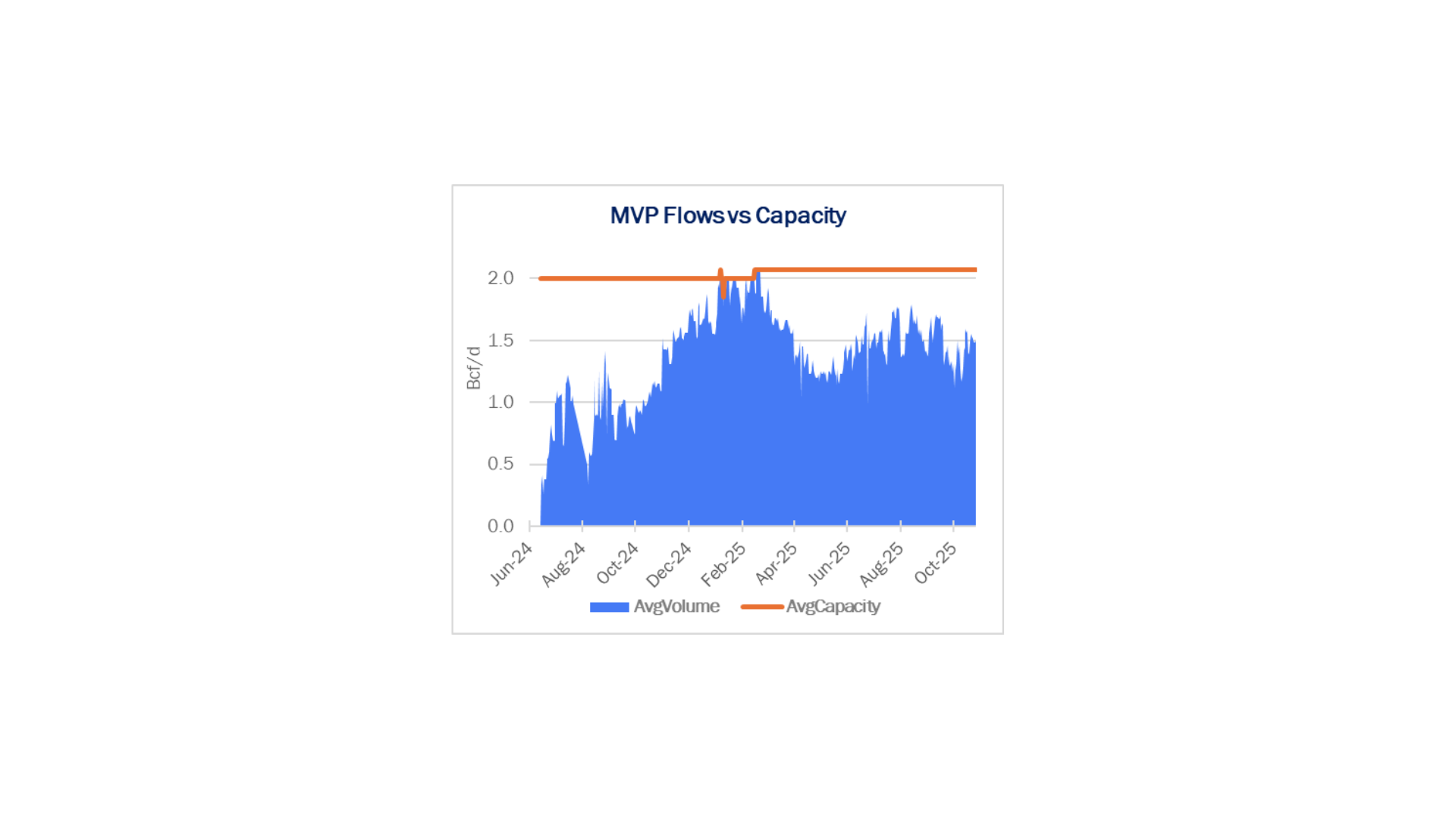Executive Summary:
Infrastructure: EQT has upgraded plans for a compression expansion on Mountain Valley Pipeline following strong interest in an open season.
Rigs: The US lost 5 rigs for the week ending Oct. 18, bringing the total rig count to 515.
Flows: US natural gas volumes in pipeline samples were flat W-o-W, averaging 68.6 Bcf/d for the week ending Nov. 2.
Storage: Traders expect the EIA to report a 34 Bcf injection for the week ending Nov. 24.
Infrastructure:
EQT has upgraded plans for a compression expansion on Mountain Valley Pipeline (MVP). The project, dubbed MVP Boost, was initially expected to add 500 MMcf/d of capacity, but the owner upsized it to 600 MMcf/d following strong interest in an open season.
In a project filing with the Federal Energy Regulatory Commission (FERC), MVP revealed that the shippers backing the expansion are Duke Energy (275 MMcf/d), Public Service Company of North Carolina (125 MMcf/d) and Virginia Power (200 MMcf/d). The companies have all signed long-term contracts at negotiated rates for the new capacity. EQT said the open season received over 1 Bcf/d of interest from potential counterparties.
The expansion will take MVP’s capacity to 2.6 Bcf/d from its current 2.0 Bcf/d and serve growing gas demand in Virginia and North Carolina. The project scope includes a new compressor station on MVP’s mainline in Montgomery County, VA and upgrades to three existing compressor stations. MVP expects to begin construction in winter 2026-27 and is targeting in-service in mid-2028.

MVP is currently flowing around 1.5 Bcf/d from West Virginia’s northern Marcellus/Utica production area to Station 165 on Transcontinental pipeline (Transco) in southern Virginia. The pipeline was placed into service in the summer of 2024 following years of legal battles. Flows on MVP have been seasonal through the first year and a half of operations, hitting peak capacity in January and February ’25 but decreasing in the spring shoulder season (see figure above).
Downstream constraints on Transco limit how much gas can currently flow on MVP, but Transco’s Southeast Supply Enhancement is expected to add 1.6 Bcf/d of additional capacity once it enters service in late 2027, alleviating those constraints.
See East Daley Analytics’ Northeast Supply & Demand Report for more information on MVP.

The Permian Basin at a Crossroads: Download the Latest White Paper
The Permian Basin is the heart of the US energy industry, supplying half of crude oil and NGL production and nearly 20% of natural gas. Yet market pressures are forcing changes, prompting billions in new pipeline investments and reorienting how operators approach the storied basin. East Daley’s new white paper, The Permian Basin at a Crossroads, is the first of a 3-part series looking at the shifts underway in the Permian. In this series, we reveal how LNG demand and AI data centers could transform Permian gas into a primary revenue driver. We also review the multi-billion-dollar infrastructure needed to unlock this shift, and what’s at stake for oil, gas and midstream operators. — Click here to download the The Permian Basin at a Crossroads white paper!
Rigs:
The US lost 5 rigs for the week of Oct. 18, bringing the total rig count to 515. The Permian (-5), Anadarko (-1) and Marcellus+Utica (-1) lost rigs while the Barnett (+1) and Denver-Julesburg (+1) gained rigs W-o-W.
At the company level, ET (-6), WES (-3), EPD (-2), MPLX (-1), ENLC (-1) and Hess (-1) lost rigs while PSX (+3), TRGP (+2) and M6 Midstream (+1) gained rigs W-o-W.

See East Daley Analytics’ weekly Rig Activity Tracker for more information on rigs by basin and company.
Flows:
US natural gas volumes in pipeline samples were flat W-o-W, averaging 68.6 Bcf/d for the week ending Nov. 2.
Major gas basin samples declined 0.2% W-o-W to 42.2 Bcf/d. The Haynesville sample declined 1.2% to 9.3 Bcf/d, while the Marcellus+Utica sample gained 0.3% to 32.1 Bcf/d.
Samples in liquids-focused basins increased 0.2% to 18.5 Bcf/d. The Permian sample declined 2.6% to 6.0 Bcf/d, while the Bakken sample gained 6.1% W-o-W.

Storage:
Traders and analysts expect the Energy Information Administration (EIA) to report a 34 Bcf injection for the week ending Oct. 31. An injection of 34 Bcf would increase the surplus to the five-year average by 8 Bcf to 179 Bcf. The storage surplus to last year would flip to a slight deficit of 5 Bcf from last week’s 29 Bcf surplus.
If Thursday’s EIA report comes in as expected, working gas would end the official injection season at 3,916 Bcf, or 5 Bcf greater than East Daley’s forecast in the latest Macro Supply & Demand Report. Despite storage closing at roughly the same level as last year, that is where the comparison ends between the two seasons. The 2024 shoulder period (April-October) saw 440 Bcf less gas injected. The season started with higher overall inventory, then hot weather combined with low prices to limit injections. The 2025 injection season started with relatively low inventory, but summer temperatures were not nearly as hot as the prior summer. Higher overall prices this year also induced some fuel switching and further cut into power demand.

Injections could last another week, making the week ending Nov. 14 the first net withdrawal week of the season. Prompt and cash prices have been moving in an upward direction this week as the next 15 days are expected to be colder than previously forecast.
See East Daley Analytics’ latest Macro Supply & Demand Report for more analysis on the winter market outlook.
Calendar:

Subscribe to East Daley’s The Daley Note (TDN) for midstream insights delivered daily to your inbox. The Daley Note covers news, commodity prices, security prices, and EDA research likely to affect markets in the short term.





